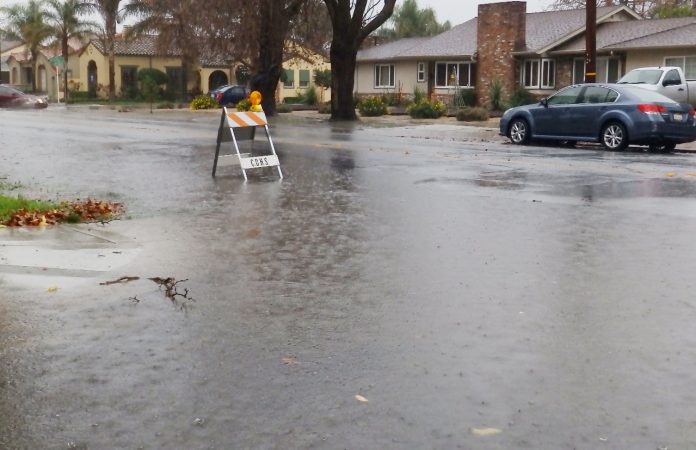You may have heard a strong El Niño could bring lots of rain this winter, but there’s another weather pattern in the region that might keep things dry. It’s a ridge of high-pressure air that’s created a huge patch of warm water off the coast, nicknamed “the Blob.”
This ridge is believed to be deflecting storms and keeping California locked in drought.
An El Niño occurs when trade winds across a large part of the Pacific Ocean die down. This allows the water to warm up more than average.
Since the Pacific covers a third of the globe, changes there affect weather around the world.
A strong El Niño typically alters the flow of a jet stream that carries storms across the Pacific from the tropics to the U.S.
In most winters, that storm track is aimed at the Pacific Northwest, supplying the region with months of wet weather.
During the El Niño year, it tends to alter the storm track in a way that makes it much more frequently pointed at California.
That happened during the 1997-98 El Niño when parts of the state saw double the average rainfall, leading to floods and mudslides that caused $550 million in damages.
This year’s El Niño could be even stronger, says Bill Patzert, a climate researcher with NASA’s Jet Propulsion Laboratory.
“The intensity of this El Niño is larger than anything at this point than I have seen in my career,” said Patzert.
But he cautioned, the trade winds could kick back up and cool the water down, resulting in a weak El Niño and not as much rain.
Still, at the moment all signs are pointing to a monster weather pattern this winter.
The Blob
University of Washington meteorologist Nick Bond coined the name “the Blob” during an interview last year.
He was remarking upon the unusually warm waters off the coast in an unusual pattern and referred to it as the Blob and the name kind of caught on.
The Blob is likely a result of a ridge of high-pressure air, sometimes called the Ridiculously Resilient Ridge, that has stayed parked above the North Pacific on and off for the past couple years.
That ridge deflected winter storms away from the West Coast, keeping things dry on land.
It also blocked the strong winds that usually cool the ocean over the winter.
Less heat was leaving the ocean. Also, the weaker winds meant less stirring of the upper part of the ocean and kind of mixing up of colder water from below.
All of this allowed the ocean off the West Coast to warm up, resulting in a Blob of warm water that eventually stretched from Alaska to Mexico.
The Match-Up
Researchers say there’s no precedent for something like the Ridiculously Resilient Ridge and the Blob interacting with an El Niño.
It’s not clear which one will win out, but here are some scenarios.
El Niño dominates
Sure, the Ridge and Blob are big, but El Niño is bigger. It is known to have a much larger impact on weather around the world.
In fact, Stanford researcher Daniel Swain thinks El Niño will likely mess with the climate patterns that have kept the Ridge and Blob in place for this long.
They’ll break apart and the entire West Coast could get a good soak.
The Blob and Ridge hold strong
Another possibility is El Niño brings the rain, but the Ridge and Blob stay put over the Northern Pacific, deflecting storms.
In this scenario, Southern California could see a wet winter but there would be less precipitation in the north, where many vital reservoirs are.
“If indeed this ridge and this warm water mass persist that could have an opposing effect of a wetting effect of a strong El Niño event,” Swain explained.
This outcome is more of a wildcard, Swain said. He thinks the most likely result is that El Niño trumps the Ridge and Blob this winter.
El Niño and the Blob team up
There’s a chance these patterns could work together.
The Blob is made of warm water, which easily evaporates, he explained.
That means the Blob could end up pumping more moisture into the air and fueling rain clouds as they pass over the ocean on their way to land.
So, we are NOT out of the woods and we must remain vigilant with our water conservation efforts! In fact, we must adopt water conservation habits and use water as efficiently as possible all the time. Not just in drought. With our state growing in population every year and with a limited water supply, we need to conserve water whenever and wherever possible.
Climate change is already affecting California’s water resources. Snowpack in the Sierra Nevada—the source of much of our runoff and our largest “natural” reservoir-could shrink by as much as 25 percent by 2050. Experts say the changing rain and snowfall patterns will result in longer periods of drought.
Speaking of water conservation, both the City of Hollister and the Sunnyslope County Water District customers have been doing a great job on conserving water. We must continue this trend. The Emergency Water Conservation Regulations that were introduced in May asked for major reductions in water use.
The state mandated that we reduce water consumption in our area from 22-28 percent compared with water usage in 2013. The chart below illustrates how well our community has been doing in regards to these efforts.
Keep it up everyone! If you need assistance in finding a leak or need additional ideas or ways to conserve water, call me at (831) 637-4378 or visit our website at www.wrasbc.org.
Shawn Novack is water conservation program manager for the Water Resources Association of San Benito County.










